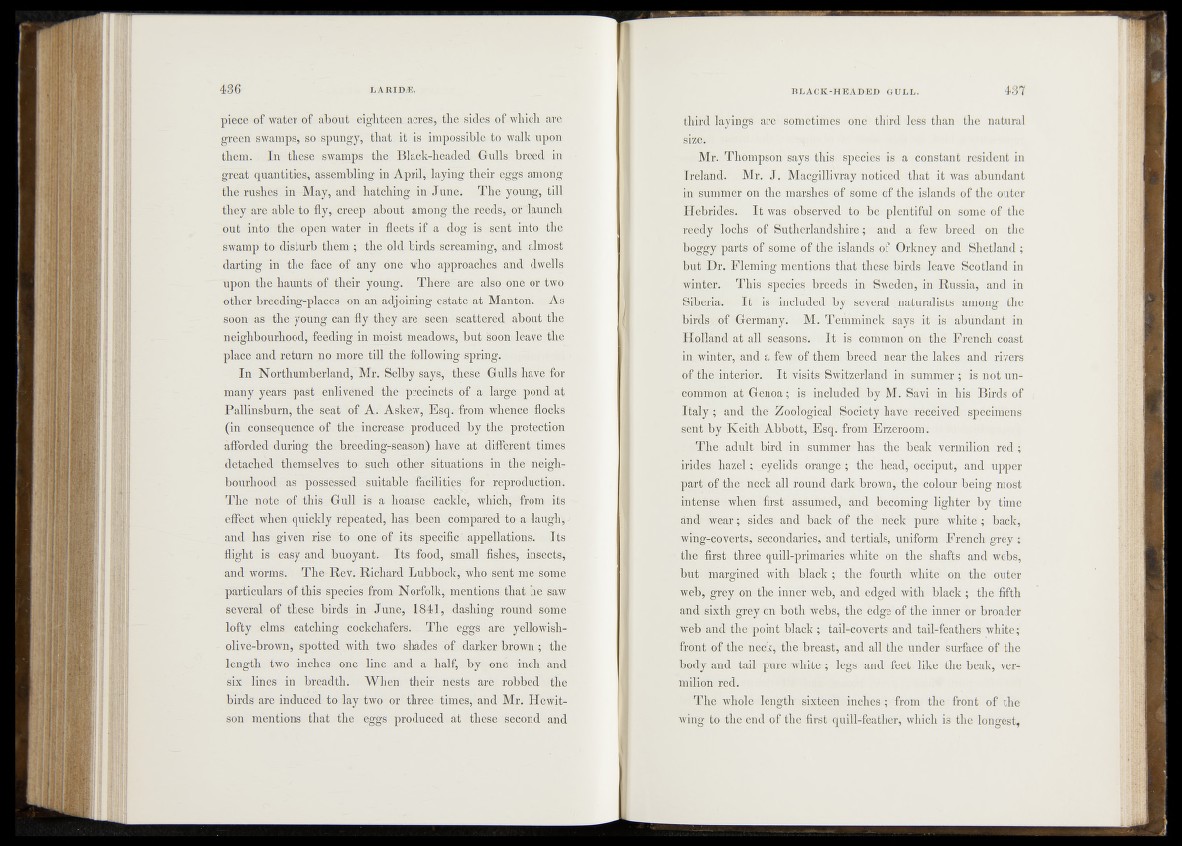
piece of water of about eigbteen_acres, tbe sides of which are
green swamps, so spungy, tbat it is impossible to walk-upon
them. In these swamps tbe Black-headed Gulls; breed in
great quantities, assembling in April, laying their eggs among
the rushes, in-May, and: hatching in June. The young, tift,
they are able to fly,, creep .about among the reeds,'io'fTaunch
jcmfc into the bpemwater in flails if a dog absent- into the
swamp to disturb them ; the.ol^lbirds screaming, and almo'sf
darting in the face of any one- whb approaches and dwells
upon the haunts of their young. , There-"are alsoJ|nb or >two
other breeding-places on an adjoining estate, at Mantoff. .As
soon as the young can fly they are seen? scattered about the
neighbourhood, feeding in moist meadows,jJ^ut. soon&leave the
place and return no more till the following spring.
In Northumberland,Air. Selby says,' these Gulls havgsfor
many years past enlivened the-iprecincts 'of a; large'^pqnd at
Pallinsburn, th e fseat of A. Askew,aEsq/ from whence floeks
(in consequence of the increase^ produced ; b y the. i protection
afforded during theAreeding-seasori) haisfe „at different times
detached themselves to such other ^situations- in-Thbe neigh-:
bourhood "as .possessed- suitable labilities!./lot/ reproduction.
The note: of this Gull i i a hoarse cackle, which', 'from its
effect when quickly repeated, has been compared to., a laugh!
and has given rise lo one of7 its specific - appellations. Its
flight is easy and buoyant. Its food, small- fishes, .'insects,'
and worms.: The-Rev. Richard Lubbock,- who sent me some
particulars of this species from Norfolk, mentions, that he saw
several of these birds in June* 1841, dashing round some
lofty elms catching cockchafer's, fe .The . eggs are yellowish-
olive-brown, spotted with two shddes fof darker brown ; the
length two inches one line and a half, by one inch and
six lines in breadth. When their nests are robbed the
birds are induced to lay two or three times, and Mr. lie wit-
son mentions that the eggs produced at these second and
third layings are sometimes one third less than the natural
size/.
Mr. Thompsdrrsays' this species is a constant resident in
ftebaid.- Mr. J . •Macgillivray notieed-that it was abundant
" Mtsummer on the marshe'seof some of the islands of the outer
HebMdesi I t was observed ton be ■ plentiful on some of the
toedy?- lochs' of »Sutherlandshire; and a few breed on the
boggy parts q&^^Mfelbf’thie1 islands of Orkney and Shetland ;
bbt Or. Fleming mentions that thisexbirds leave Scotland in
winter. Sweden, in Russia, and: in
Siberia. Ttj.id- included $by^ several ^naturalists among the
'bir&s/^f - Gertaailpi s-M». Tei^mMbk^says iWisi abundant in
Holland?at -all ’fseas^blpi It^§V-fe@mmon off the French coast
in.w'^fe'-iand a'few. of them breed near the lakes and rivers
offth’^piteiior. ■. lt^4slfe Switzerland in summer; 1% not uncommon
at-iGeffda^ w^ilielnaded I pM . Savi in his Birds of
Ita ly ; and- tKei^oofegicajl.l^ffi'etyAave^received specimens
seht-by Eeit&ATObt^'Esq. from Erzeroom: n '
The hd^^bir-d m -summerl'*haps'fi/the beak vermilion red ;
iridesfr.hazibl ;-||^eli#s^inaBg.e^ the head, -oCfeiput, and upper
part'-©f the$ rtee^' all round dark- brown, the'colour being most
iiiten'SeiPwhen first as^umfed^eand becoming lighter by time
dnd wear ;• sides and back .of thevmeck pure white; back,
w l» 1-,coverts, secondaries,t^hd tertials, uniform French grey ;
th-d-first three quill-prirnalaess White 30 k the shafts and webs,
'hpf . margined'-with. black ; tke^fd^th -’whit^^on the outer
Webv^gre-ySo'n^th efinner.- web, and edged with black ; the fifth
and sixth « grey on both webs, the edge of the inner or broader
web and the point black«; tail-eover-ts and tail-feathers white;
front of the neck, the breast, and a ll the under surface of the
body hard tail pure «white:; legs and feet; like the beak, vermilion
red.'
terThe whold:Length sixteen inches ; from th e ' front of the
wing to the end of the first quill-feather, which is the longest,